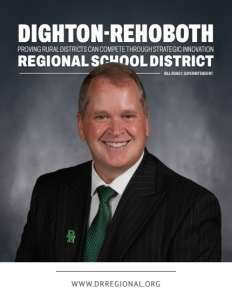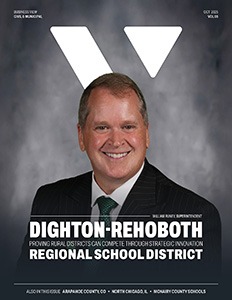Proving Rural Districts Can Compete Through Strategic Innovation
An innovative approach demonstrates that small districts can compete through strategic vision and community collaboration.
In the rolling hills of southeastern Massachusetts, where the Taunton River once carried merchant ships to distant ports, a different kind of enterprise now shapes the future. The Dighton-Rehoboth Regional School District, serving two historic towns with a combined population of just over 16,000, has quietly embraced educational innovation in rural New England. What distinguishes this 2,500-student district is a leadership philosophy that treats education as both a public service and a strategic enterprise.
Superintendent Bill Runey frames the district’s approach with three core concepts that drive every decision. “We seek to empower our staff to ignite curiosity and learning in order to best shape the future of our students — and, in doing so, shape the future of the district itself,” he explains.
Backed by trusted partners—from the School Committee to union leadership—Runey’s vision reflects a rare alignment of district leadership, elected officials at the state and local levels, and frontline educators working toward a common future.
“You’ll see a lot of our marketing strategies are based around empower, ignite, and shape.” The mission arose from recent strategic planning sessions to foster unity between two communities by focusing on common goals and the future of their children. The #WeAreDR mantra has become the words to live by in the district.
Runey defines his role as equal parts instructional and innovative leadership and community-facing advocacy for education in both towns. “I believe that I have to champion education in our two towns,” he states. “I believe my visibility and approachability are key to fostering trust and connection across both communities. That presence allows me to inspire confidence, build unity, and ensure our schools remain a worthy investment for both communities.”
Supporting the Whole Child and Empowering Educators
The district’s educational philosophy centers on a principle that Assistant Superintendent Fred Souza learned early in his career: comprehensive student development requires equally comprehensive staff support. “I remember in college, my professor was often asked, ‘What do you do every day?’ He’d say, ‘I teach the whole child—I just happen to use mathematics to do it,’” Souza recalls. “We’re in the business of developing well-rounded human beings. That’s always been the goal.”
Post-pandemic realities have intensified this approach. Massachusetts students lead the nation in reading and math assessments, yet local challenges persist. In Dighton-Rehoboth, only 40% of students test proficient in math and 44% in reading, figures that drive the leadership’s focus on comprehensive support systems.
“Coming out of the pandemic, our students often need more support,” Souza explains. “In every building, we ensure our counselors, adjustment counselors, and guidance staff have the resources to help students access the strongest academic experience possible each day.”
The district’s staff-first philosophy challenges conventional educational priorities. Souza employs a fitting analogy to explain the approach: “Many times, administrators would say the focus is always on students first. We totally get that, but we try to bring it back to the airplane metaphor where when you’re on an airplane, they say you need to put your mask on first before you help your child. As a Central Office Leadership Team, it is our job to make sure that our teachers are first prioritizing themselves to take care of kids.”

DREAM Seminars and Professional Growth
Professional Development in most school districts follows predictable patterns: external consultants, mandated training sessions, and one-size-fits-all workshops. Runey proudly shared Dighton-Rehoboth has disrupted this model with an internally-driven system that turns teachers into educational entrepreneurs. The district created “DREAM seminars,” an acronym for Dighton-Rehoboth Educators Aspiring for Mastery. The program operates as an internal marketplace where teachers pitch their own Professional Development ideas.
“Every year we put out an RFP for proposals, and our teachers align their submissions with our district strategic plan, DRiving Toward 2030,” Runey explains. “Teachers identify which elements of the strategic plan their session supports, and our Professional Development committee—made up of paraprofessionals, teachers, and administrators —reviews the proposals to select the best fit for DREAM Seminars.”
External partnerships supplement internal expertise. “We also look to the local universities. We have some close partnerships, one with Bridgewater State University. We’re working with Roger Williams University as a partner as well,” Souza notes. Current training priorities address evolving classroom challenges. “One of the things that has been high on the radar for teachers is working with reluctant students, working with students that might have a traumatic background,” Souza says. “We make sure that we are tailoring our PD offerings to make sure that we’re hitting everything that our staff needs.”
AI, Cybersecurity, and Future-Ready Classrooms
While many educational leaders approach artificial intelligence with caution, Director of Instructional Technology Lauren Harwood embraces it as a transformational tool requiring strategic implementation. “AI is an incredibly powerful tool, and our philosophy is to use AI responsibly and educate our students on how to use it responsibly. Not just like, oh, this can write an essay for me,” Harwood explains. “We teach them, or we help them use it so they’re using it responsibly, ethically, and making sure that the information that they’re receiving from AI is accurate.” The district employs vetted platforms like Magic School rather than allowing unrestricted access to consumer AI tools.
Cybersecurity education has become equally critical. Massachusetts schools face increasing digital threats, prompting districts statewide to prioritize infrastructure protection and user education. “I think the more informed people are, the less likely they are to click something they shouldn’t,” Harwood observes. “I’ve explored several staff training tools, and most include a student component—like videos or phishing simulations—to help everyone benefit from cybersecurity education.”
Harwood’s technology strategy emphasizes balance between digital tools and traditional learning methods. “Our learning environments are interactive and intentional—teachers are energized by tools that not only fit the space, but also drive student collaboration, exploration, and stronger instructional outcomes,” she says.

Career Pathways and Real-World Connections
Massachusetts operates the nation’s most rigorous vocational education system through Chapter 74 programs, which maintain strict standards for curriculum, equipment, and industry partnerships. With over 55,000 students enrolled statewide in these state-approved programs, the commonwealth has earned recognition as the “gold standard” for Career and Technical Education. Dighton-Rehoboth leverages this framework through seven robust CTE offerings that connect classroom learning directly to regional employment opportunities.
We’re proud to offer programs like Engineering Design and Drafting, TV and Video Production, Early Childhood Education, Automotive Technology, Advanced Manufacturing, Marketing, and Carpentry,” Runey shares. Chapter 74 funding streams provide additional resources, allowing districts to maintain expensive equipment and industry-standard facilities. The programs operate under Massachusetts General Law requirements that ensure graduates meet professional certification standards.
Runey takes particular pride in expanding cooperative education placements during his tenure. “One of the things I’m proudest of over the past three years is how we’ve grown our co-op programs,” he explains. “We now have students placed in both of our towns—and even neighboring towns—gaining real-world experience that provides meaningful, career-aligned exposure.”
The district’s partnership with Ford Motor Company exemplifies how rural schools can access corporate resources typically reserved for urban districts. “That partnership has given our students the opportunity to virtually learn that very up-to-the-minute type of technology,” Runey explains. “Because Ford values us and has seen tremendous participation from our automotive technology students, they are opening their doors in terms of employment.” Recently, the district secured the donation of a never-driven Ford Explorer equipped with advanced systems including backup cameras and modern braking technology from Tasca Automotive Group.

Safety, Security, and Capital Investments
When Runey arrived in summer 2022, he discovered a glaring security gap that demanded immediate attention. “Only one of our five buildings, the high school, was equipped with security cameras,” Runey recalls. “I immediately made safety and security a priority.” The finding highlighted how rural districts often lag urban counterparts in basic security infrastructure, despite being susceptible to similar threats.
The leadership team approached the challenge systematically, partnering with local emergency services to develop comprehensive security protocols. “We locked arms with police and fire in both Dighton and Rehoboth to get their recommendations in terms of how we could best keep safe and secure environments for our students and for our staff,” Runey explains. The collaboration included developing standardized crisis response procedures using the Crisis Go application across all district buildings.
Implementation required creative financing strategies unique to regional school districts. Unlike traditional districts that own their buildings, Dighton-Rehoboth leases facilities from both towns, creating complex funding relationships. “I explained to both towns that since they own the buildings we lease, we needed their backing to secure the budget dollars required to make the safety improvements a reality,” Runey states.
Runey’s collaborative strategic approach proved successful. “Each of our towns stepped up through the town meeting warrant process, where taxpayers come to a town meeting, and they vote on certain aspects of the budget,” Runey reports. “They were able to provide us with nearly a quarter of a million dollars across the two towns in safety and security upgrades.” The district partnered with Custom Computers to install comprehensive camera and door-monitoring systems in all five buildings within eighteen months. All five buildings are significantly safer as a result.
Future Priorities for Growth and Sustainability
“Our top priority is a balance between fiscal responsibility and best serving our students and our staff,” Runey states. “If we’re going to empower our staff to ignite that curiosity and learning in our students, we have to be able to keep up financially.” The challenge points to broader demographic trends affecting rural New England districts, where declining birth rates and school choice options create competitive pressures.
Enrollment attrition is the most immediate concern. “We have seen some attrition from eighth grade to ninth grade in our district,” Runey acknowledges. “We’re seeing students opt for private schools, while others are exploring opportunities at regional vocational-technical schools across the area.” With Massachusetts operating ninety Chapter 74 programs across multiple districts, students have unprecedented access to specialized training that smaller districts struggle to match.
Souza prioritizes resource allocation to strengthen core academic offerings. “Putting resources in the hands of our educators and providing them with high-quality instructional materials is vital,” he admits. “From the moment Bill and our team stepped in, we focused on providing what teachers need to improve student learning experiences.” Professional Development remains central to retention strategies in a competitive employment market where 95.4% of district teachers hold proper licenses.
Runey sees artificial intelligence as both an opportunity and a challenge for the immediate future. “AI is certainly top of mind. We don’t just toss students the keys and hope they figure it out—we teach them how to drive cars responsibly. That same philosophy applies to staff. It’s my job as a leader to make sure everyone is equipped to use AI in safe, smart, and meaningful ways.”
AT A GLANCE
Who: Dighton-Rehoboth Regional School District
What: Rural Massachusetts school district serving 2,500 students across five schools with innovative CTE programs, AI integration, and corporate partnerships
Where: Dighton and Rehoboth, Massachusetts
Website: www.drregional.org
PREFERRED VENDORS
The Great Schools Partnership : www.greatschoolspartnership.org
The Great Schools Partnership is a nonprofit school-support organization working to redesign public education and improve learning for all students. Our team consists of former educators and school leaders with experience across all levels of the education system, from classrooms to statehouses.
Custom Computer Specialists : www.customonline.com
Custom Computer Specialists is a leading innovative technology solutions provider that has been serving K-12 throughout the Northeast for over 45 years. Custom offers an extensive range of products and services aligned with our clients’ needs including Cybersecurity, Physical Security, Cloud, Networking, Data Center, Collaboration, Managed Services, Managed Security, E-Rate, IT Consulting and Implementation Services. Custom is an active and approved Vendor on many State and Consortium Contracts.
The Navicon Group : www.thenavicongroup.com
The Navicon Group is a total solutions provider specializing in both Physical and Cyber Security, as well as Managed IT Services, backed by 24/7 monitoring and a SOC (Security Operations Center) to ensure all your IT needs are met from start to finish.





